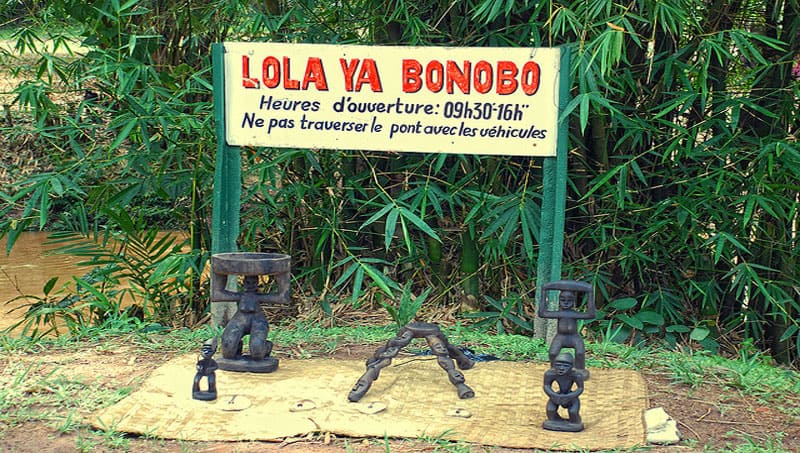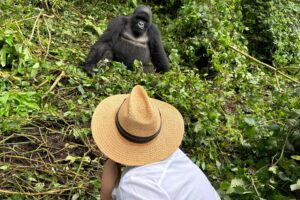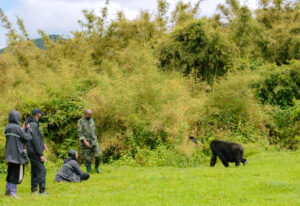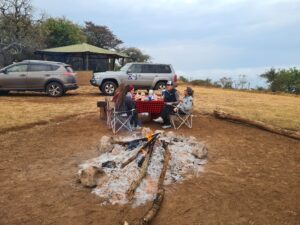Welcome to Lola ya Bonobo Sanctuary
Great apes face extinction from threats mainly caused by human activities such as logging in habitat areas, bush-meat hunting, and pet trade. Many African countries have domestic laws prohibiting the capture and trade of endangered great apes from the wild. However, the enforcement of these laws is difficult without addressing how to care for illegally owned animals. To address the problem, various “sanctuaries” have been established to provide homes for confiscated great ape orphans. For example, 13 chimpanzee sanctuaries in 11 African countries now house over 600 chimpanzee orphans 1. However, there is only one bonobo sanctuary in the world, the Lola Ya Bonobo sanctuary, located approximately 25 km southwest of Kinshasa, the capital of the Democratic Republic of the Congo, and directed by Ms. Claudine André 2.
The sanctuary was created by Les Amis des Animaux au Congo (AAC; “Friends of Animals in Congo”), a Congolese organization created in 1994 by Ms André 3. She organized the AAC to support animals in the Kinshasa Zoo. Soon afterwards, an illegally owned bonobo was confiscated in collaboration with the government, and the AAC began to care for young orphan bonobos. In 1998, the AAC moved the bonobos to the grounds of the American school in Kinshasa and created a nursery-sanctuary, which continued to receive illegally captured bonobos. In 2002, the sanctuary was moved to its current location and changed its name to Lola Ya Bonobo; meanwhile AAC also changed its name to Les Amis des Bonobos du Congo (ABC; “Friends of Bonobos in Congo”). Lola Ya Bonobo now occupies about 30 ha of land previously owned by a French businessman. This area is divided into five enclosures for the bonobos: two large-sized, one middle-sized, and two small-sized enclosures. The enclosures, surrounded by electric fences, include 20 m tall forest areas, swampy areas, and a small river; thus, the environment is complex and similar to natural bonobo habitat.
In February 2007, we had the opportunity to visit Lola Ya Bonobo sanctuary and stay for 3 weeks. At the time of our stay, 53 bonobos lived there, including four infants born in the sanctuary. The following is a summary of our observations during the 3 weeks, which we hope will illustrate daily life at the sanctuary.
Among the 53 bonobos, eight were 3–5 year olds who were dependent on human substitute mothers. There were about 20 local people working for the sanctuary. Of these, four worked as substitute mothers. They took care of the young bonobos from morning to evening, cleaning them, giving them milk and other foods, and letting them play in a play yard. In the evening, the bonobos were brought to cages to spend the night.
At the beginning of our stay, the remaining 45 individuals lived in four mixed-age groups in which adults, their infants, and youngsters who had been “weaned” from human substitute mothers lived together. The first group, consisting of 15 individuals, used one of the large enclosures. The second group, consisting of 13 individuals, used the other large enclosure. The third group, consisting of 11 individuals, used the mid-sized enclosure. The last group consisted of 6 individuals who were kept in the small enclosure.
All members of the mixed-age groups were kept in indoor quarters during the night. In the morning (around 0600 hr), staff members gave them water supplemented with minerals and sugar and visually inspected the health of the bonobos. The groups were then released into their respective enclosures at around 0630 hr after the safety of the enclosures was ensured. Occasionally, the bonobos received external applications of anti-parasite medicine before being released into the enclosures. At other times, while the bonobos were still in their nighttime quarters, workers mowed the grass near the electric fence to prevent a short circuit. During the day, staff members gave the bonobos various types of fruits, vegetables, sugarcane, peanuts, breads, eggs, and milk. In addition to caring for the bonobos, the sanctuary sets a high priority on education 4. Educational tours for Congolese children took place during our visit, and the children eagerly observed the bonobos and attended the talks given by the staff.
The composition of bonobo members within a group is decided by taking into consideration their compatibility with each other. Young orphans who are dependent on human mothers will be integrated into a social group and begin to learn necessary skills such as foraging and danger avoidance from conspecific group members. We had the opportunity to observe the integration of groups during our stay. Three of the six individuals in the small enclosure were young individuals (approx. 4–5 years of age) who had just finished their time of care by human mothers. Three subadult (approx. 8–9 years of age), good-tempered individuals were chosen from the first mixed-age group, and these three older and three younger bonobos were allowed to spend time with each other in the small enclosure. On 12 February 2007, four individuals from the first mixed-age group were moved to the group in the small-sized enclosure as the next step in the integration of the young individuals. Two of these four individuals were adult females who were expected to protect the young individuals after integration; another was a juvenile, who was included as a possible playmate; and the last was a male over 10 years old. The bonobos emitted many vocalizations and engaged in affinitive interactions such as embracing and GG-contact during their first encounter; the excitement ceased within approximately 1 hour, without any aggressive interactions. On the following day, the members of the small-sized enclosure, including the three young individuals, were released into the large enclosure to join the remaining 10 members of the first mixed-age group. An adult male performed display behavior and ran around the newcomers, but did not show any aggressive physical contact. All of the members gathered around the newcomers and engaged in numerous vocal and socio-sexual exchanges. Most of the members then climbed a large, 20 m tall tree and continued to make vocal exchanges; the event ended peacefully after approximately 1 hour.
The integration of the second and third mixed-age groups was also carried out over the course of the next few days. The reactions of bonobos during their first encounters were similar to those described above. They engaged in many vocal and socio-sexual exchanges, and the integration ended without harmful interactions after approximately 1 hour. After a series of integrations and recombinations, two new mixed-age groups had formed by the end of our stay: the first group consisted of 19 individuals (10 males and 9 females, 0–21 years old), excluding a female separated for preparation for delivery and a male selected as her cagemate who were originally members of this group; the second group consisted of 24 individuals (18 males and 6 females, 1–23 years old).
While in their enclosures, the bonobos engaged in grooming, solo and social play, GG-contact, and other activities typical of their species. They also displayed some behaviors that have not been observed in their wild counterparts such as stone-tool use to crack open oil palm nuts, the use of plant materials to drink water, and the use of probing sticks. One conspicuous feature was their familiarity with water. They did not literally swim, but would enter the water to just below their shoulders (Fig. 1). These examples show the flexibility of their behavior and the great influence of post-natal experience for bonobos.
The sanctuary is now considering possible reintroductions of bonobos into the natural habitat as another tool for managing wild bonobo populations 4. This lolo bonobo sanctuary thus plays important roles in conservation, education, and research on this endangered closest relative of humans.
Ninety minutes west of Kinshasa, just beyond the city’s sprawl, this excellent project provides a home for orphaned bonobos. Long thought to be chimpanzees, bonobos are actually a separate species known for being much more peaceful than their cousins. They’re also endangered, with only around 50,000 surviving in the wild. Trails here lead around the large, forested enclosures, but the playful bonobos often hang out right at the front, especially in the morning.
The sanctuary is 8km off the Matadi road. If you’re patient, you can hitch those last 8km off the highway. A hire car with driver from Kinshasa will cost US$100, but in the wet season you’ll need a 4WD (US$200).
Bonobos (Pan paniscus) are a great ape species found exclusively in the Democratic Republic of Congo. They are endangered and may become extinct in the next 75 years. Only between 50,000 and 75,000 remain in the wild today. You can help us protect this species by supporting the Lola Ya Bonobo Sanctuary.
Lola ya Bonobo is the world’s only organization to provide lifetime care to bonobos orphaned by the illegal trade in endangered wildlife. They are on the front line in the battle to protect bonobos in the only country they are found – The Democratic Republic of Congo.
They rescue orphan bonobos from the illegal bushmeat trade, rehabilitate these bonobos at Lola ya Bonobo, and when possible release them back to the wild at Ekolo ya Bonobo.




